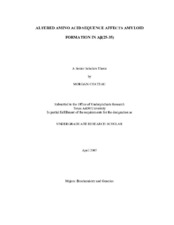| dc.description.abstract | Many neurodegenerative diseases are associated with protein misfolding where the protein forms β-sheet rich polymers called amyloid. Alzheimer’s disease (AD) is an amyloid aggregation disease involving the Aβ(1-42) peptide fragment of the Amyloid Precursor Protein (APP) in the nervous tissue of the brain. Within the peptide there are regions thought to be more critical for amyloid formation; one of which is Aβ(25-35). This sequence has the ability to form amyloid at sufficient peptide concentrations. Within this region, residues 33-35 have been found by terminal deletions to be a core region (1), the residues necessary for amyloid formation. Using Cys-scanning mutagenesis the estimated core region (31-34) is slightly different. Previous papers have shown, the peptide loses the ability to form amyloid fibrils when the sequence of amino acids is changed (2). For this experiment, four different Aβ(25-35) sequences were tested, each having the same composition but a different sequence. FPLC was used in conjunction with Thioflavin-T fluorescence to monitor amyloid development. The results showed a definite effect on amyloid formation as compared to wild type. Sequence S-N showed nearly no change in behavior. Sequence S-M appeared to loose all amyloid forming ability. The remaining two sequences were unable to remain in solution long enough to be accurately tested. | en |


